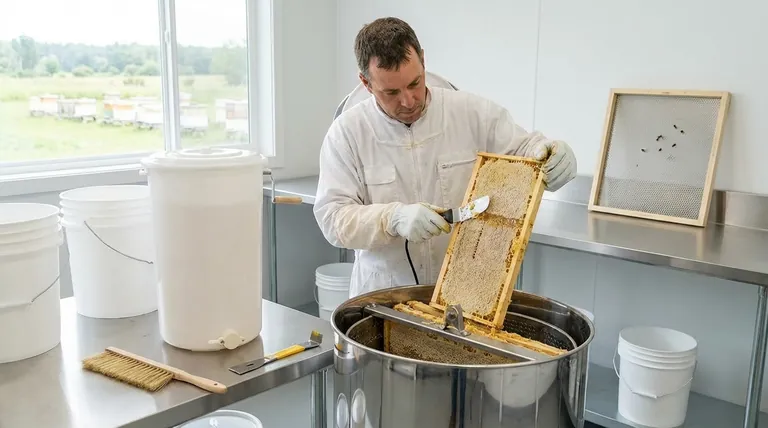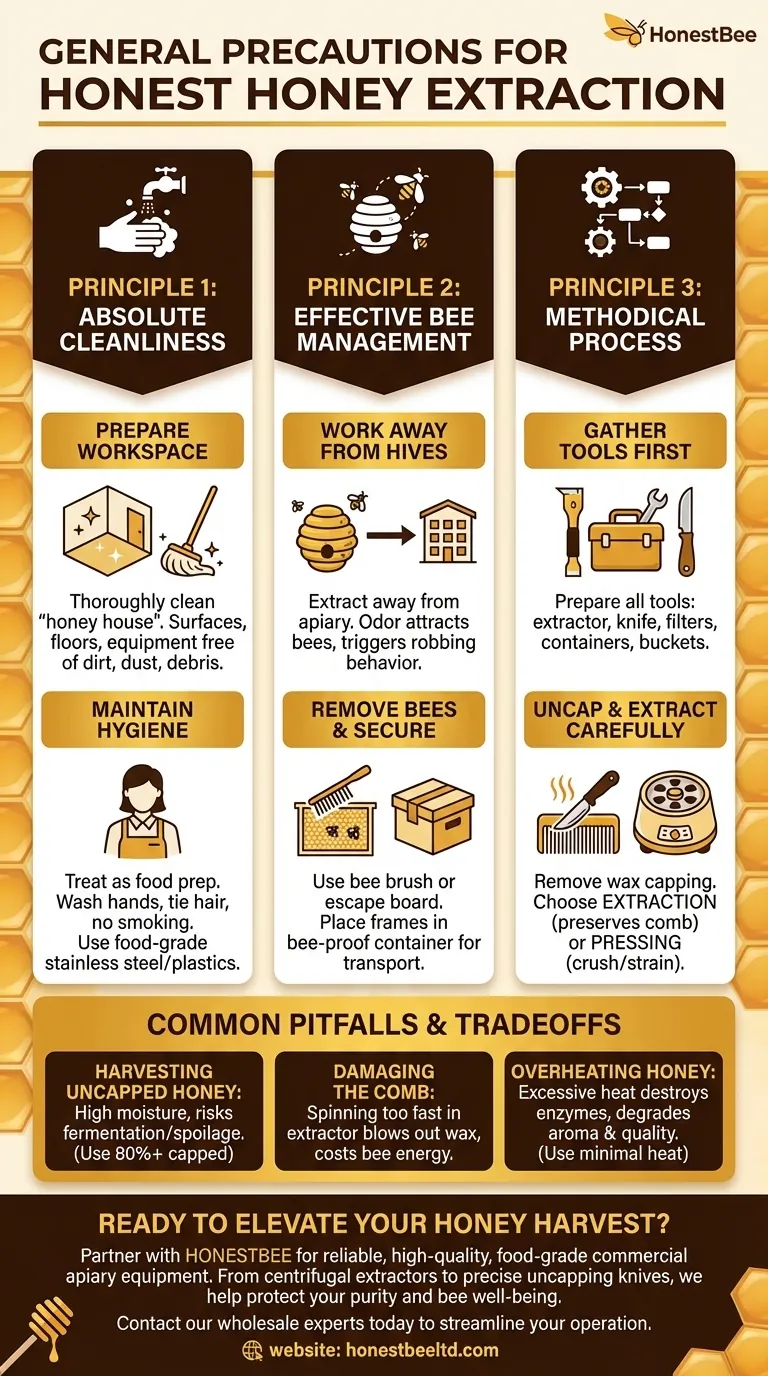The most important precautions for honey extraction revolve around three core principles: maintaining absolute cleanliness, managing bee behavior, and preparing your equipment methodically. Because honey is a food product, you must treat your workspace like a kitchen, keeping it and yourself impeccably clean. It is also critical to perform the extraction away from the hives to prevent agitating the bees, who are attracted to the scent of open honey.
Successful honey extraction is not just a mechanical process; it is a careful balance of food safety hygiene, calm bee management, and operational efficiency. Neglecting any one of these areas can compromise the quality of your honey and the safety of your apiary.

Principle 1: Prioritize Absolute Cleanliness
Honey is food. Any contamination introduced during extraction will end up in the final product. This principle is non-negotiable for producing safe, high-quality honey.
Prepare Your Workspace
Your extraction area, often called a "honey house," must be thoroughly cleaned before you begin. Ensure all surfaces, floors, and equipment are free of dirt, dust, and debris.
Maintain Personal Hygiene
Treat the process as if you were preparing a meal. Wash your hands thoroughly, clean under your fingernails, and tie back long hair. Refrain from activities like smoking that could introduce contaminants.
Use Food-Grade Equipment
All containers, filters, and tools that come into contact with the honey must be made of food-grade materials, such as stainless steel or specific plastics, to prevent chemical leaching.
Principle 2: Manage Your Bees Effectively
The smell of honey and exposed comb is a powerful attractant for bees. Poor management can lead to a chaotic and stressful experience for both you and your colony.
Work at a Distance from the Hives
Never extract honey right next to your apiary. The strong odor will attract your bees and potentially bees from other hives, which can trigger agitated behavior and "robbing," where bees attempt to steal the honey back.
Remove Bees from the Frames
Before bringing frames to your extraction area, you must remove the bees. This is typically done using a bee brush to gently sweep them off or by placing a bee escape board on the hive a day in advance, which allows bees to leave the honey supers but not re-enter.
Secure Your Harvest for Transport
Once the frames are bee-free, place them immediately into a sealed, bee-proof box or container. This prevents bees from finding and descending upon the frames as you transport them from the apiary to your extraction space.
Principle 3: Execute a Methodical Process
A well-organized workflow minimizes stress, maximizes your honey yield, and protects your equipment.
Gather All Tools Beforehand
Prepare everything you need before you even go to the hive. This includes a hive tool, bee brush, sealed containers for transport, a honey extractor or press, an uncapping knife, filters, and storage buckets.
Uncap the Honeycomb
Honey cells are sealed with a wax capping. This must be removed to release the honey. Use a heated uncapping knife or a serrated knife to slice off the thinnest possible layer of wax from the comb's surface.
Extract the Honey
The two primary methods are extraction and pressing.
- Extraction uses a centrifugal spinner to sling honey out of the comb, preserving the comb for the bees to reuse.
- Pressing (or crush and strain) involves breaking up the comb and pressing or straining it to separate the honey from the wax.
Understanding the Trade-offs and Common Pitfalls
Every decision in the extraction process has a consequence. Understanding these helps you avoid common mistakes.
Pitfall: Harvesting Uncapped Honey
Only extract from frames that are at least 80% "capped." Uncapped honey has a higher moisture content, meaning it has not been fully "cured" by the bees. Extracting this "unripe" honey can lead to fermentation and spoilage.
Pitfall: Damaging the Comb
When using a centrifugal extractor, start slowly and gradually increase the speed. Spinning too fast, especially with heavy frames, can blow out the delicate wax comb, forcing the bees to expend significant energy rebuilding it.
Pitfall: Overheating the Honey
If you use a heated knife for uncapping or warm your honey to make it flow better for filtering, use minimal heat. Overheating honey can destroy its beneficial enzymes and delicate aromas, degrading its overall quality.
Making the Right Choice for Your Goal
Your approach should align with your scale and priorities as a beekeeper.
- If your primary focus is simplicity and low cost: The crush and strain (or pressing) method is effective for small-scale hobbyists and requires no expensive equipment.
- If your primary focus is efficiency and long-term hive health: Investing in a centrifugal extractor is superior, as it preserves the drawn-out comb, saving your bees immense time and energy on the next honey flow.
- If your primary focus is premium honey quality: Prioritize using only fully capped frames, apply minimal to no heat, and ensure every piece of equipment is impeccably clean and food-grade.
By approaching the harvest with care and preparation, you honor the incredible work of your bees and ensure the final product is pure and safe.
Summary Table:
| Precaution Area | Key Action | Why It Matters |
|---|---|---|
| Cleanliness | Use food-grade equipment and maintain personal hygiene. | Prevents contamination of the honey, ensuring it is safe for consumption. |
| Bee Management | Extract away from hives and remove bees from frames before transport. | Prevents bee agitation, robbing behavior, and ensures a calm, safe process. |
| Methodical Process | Gather all tools beforehand and uncap/ extract carefully. | Maximizes honey yield, protects equipment, and maintains comb integrity. |
| Common Pitfalls | Avoid harvesting uncapped honey and overheating the honey. | Preserves honey quality, prevents fermentation, and retains beneficial enzymes. |
Ready to Elevate Your Honey Harvest? Partner with HONESTBEE.
A successful harvest depends on reliable, high-quality equipment. At HONESTBEE, we supply commercial apiaries and beekeeping equipment distributors with the durable, food-grade tools needed for a flawless extraction process—from efficient centrifugal extractors that preserve comb to precise uncapping knives.
Let us help you protect your honey's purity and your bees' well-being. Contact our wholesale experts today to discuss your equipment needs and streamline your operation.
Visual Guide

Related Products
- Plastic Hand Crank 2 Frame Honey Extractor Low Price
- 6 Frame Manual Stainless Steel Honey Extractor Beekeeping Equipment
- HONESTBEE 3-Frame Manual Acrylic Honey Extractor
- Stainless Steel 3 Frame Manual Honey Extractor Spinner for Bee Honey Extraction
- 2 Frame Stainless Steel Manual Honey Spinner Extractor for Beekeeping
People Also Ask
- What makes polyurethane foam environmentally friendly? The Surprising Benefits of a Durable, Inert Material
- Why are manual extractors popular among beginner beekeepers? A Guide to Starting Simple & Saving Money
- Can honey be harvested from frames with brood? The Critical Rule for Healthy Bees & Pure Honey
- How do you extract honey by hand? A Guide to Crush & Strain vs. Manual Extractor
- What is the cut and strain method of honey extraction? A Simple, Low-Cost Approach for Hobbyists



















